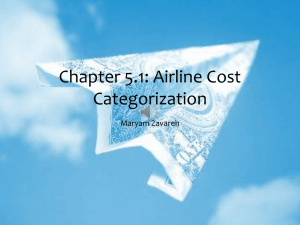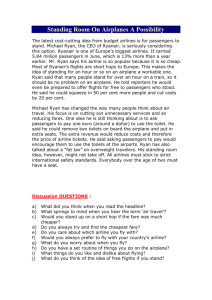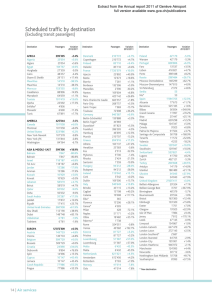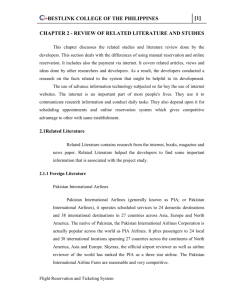Transportation – The Airline Industry
advertisement
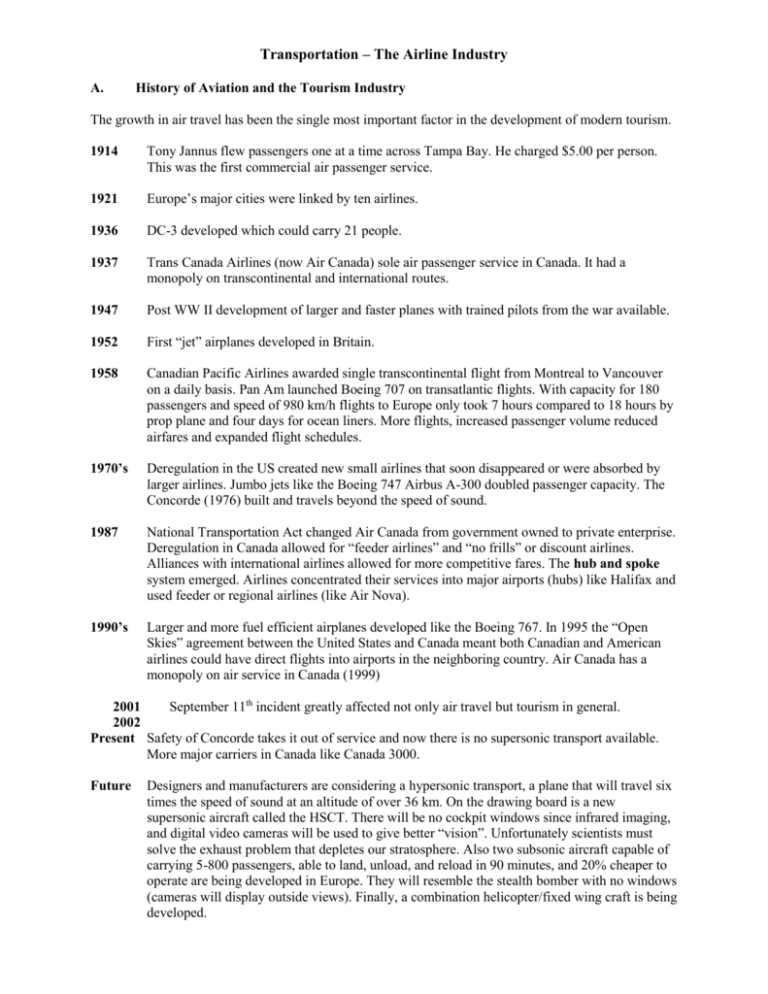
Transportation – The Airline Industry A. History of Aviation and the Tourism Industry The growth in air travel has been the single most important factor in the development of modern tourism. 1914 Tony Jannus flew passengers one at a time across Tampa Bay. He charged $5.00 per person. This was the first commercial air passenger service. 1921 Europe’s major cities were linked by ten airlines. 1936 DC-3 developed which could carry 21 people. 1937 Trans Canada Airlines (now Air Canada) sole air passenger service in Canada. It had a monopoly on transcontinental and international routes. 1947 Post WW II development of larger and faster planes with trained pilots from the war available. 1952 First “jet” airplanes developed in Britain. 1958 Canadian Pacific Airlines awarded single transcontinental flight from Montreal to Vancouver on a daily basis. Pan Am launched Boeing 707 on transatlantic flights. With capacity for 180 passengers and speed of 980 km/h flights to Europe only took 7 hours compared to 18 hours by prop plane and four days for ocean liners. More flights, increased passenger volume reduced airfares and expanded flight schedules. 1970’s Deregulation in the US created new small airlines that soon disappeared or were absorbed by larger airlines. Jumbo jets like the Boeing 747 Airbus A-300 doubled passenger capacity. The Concorde (1976) built and travels beyond the speed of sound. 1987 National Transportation Act changed Air Canada from government owned to private enterprise. Deregulation in Canada allowed for “feeder airlines” and “no frills” or discount airlines. Alliances with international airlines allowed for more competitive fares. The hub and spoke system emerged. Airlines concentrated their services into major airports (hubs) like Halifax and used feeder or regional airlines (like Air Nova). 1990’s Larger and more fuel efficient airplanes developed like the Boeing 767. In 1995 the “Open Skies” agreement between the United States and Canada meant both Canadian and American airlines could have direct flights into airports in the neighboring country. Air Canada has a monopoly on air service in Canada (1999) 2001 September 11th incident greatly affected not only air travel but tourism in general. 2002 Present Safety of Concorde takes it out of service and now there is no supersonic transport available. More major carriers in Canada like Canada 3000. Future Designers and manufacturers are considering a hypersonic transport, a plane that will travel six times the speed of sound at an altitude of over 36 km. On the drawing board is a new supersonic aircraft called the HSCT. There will be no cockpit windows since infrared imaging, and digital video cameras will be used to give better “vision”. Unfortunately scientists must solve the exhaust problem that depletes our stratosphere. Also two subsonic aircraft capable of carrying 5-800 passengers, able to land, unload, and reload in 90 minutes, and 20% cheaper to operate are being developed in Europe. They will resemble the stealth bomber with no windows (cameras will display outside views). Finally, a combination helicopter/fixed wing craft is being developed. B. The Air Transportation System The federal department responsible for all of Canada’s transportation systems is called Transport Canada. It sets the rules and regulations for licensing pilots, flight engineers, and mechanics. It provides licenses for each commercial aircraft, and it determines the number of hours a plane can fly between maintenance checks. Since 1996 NAVCAN a private corporation owns and controls air navigation, air traffic control, flight information, weather briefings, electronics, and other non-core services. Scheduled Air Service: includes those airlines that operate with published timetables, on defined domestic or international routes. Chartered Air Service: arrange to fly wherever a group has planned to visit. Usually the rates are lower than scheduled air service, and is usually arranged by a tour operator. Many scheduled air services (i.e. Air Canada) offer charter service as well. Air Transat is an example of a charter service. Airports A present-day airport consists of many different components: passenger terminals, parking lots, control towers, hangars, runways, taxiways, loading aprons, chapels, customs and immigration facilities, restaurants and bars, lounges reserved for first class travelers, souvenir shops, car rental agencies, banks or money exchange services, and administrative offices. Some airports have hotels and direct access to subways. Licensing Levels Only two licensing levels impact the tourism industry significantly. Level One consists of major airlines with transcontinental and/or international routes. Air Canada falls in this category. Level two are regional carriers. Their routes cover specific regions. Air Nova was one of these. C. The Eight Freedoms of the Air First Freedom: Second Freedom: Third Freedom: Fourth Freedom: Fifth Freedom: Sixth Freedom: Seventh Freedom: Eighth Freedom: The right of an airline to over-fly one country to get to another. i.e. Air Canada departs Toronto, flies over the US to reach Mexico City. The right of an airline to land in another country for a technical stopover like refueling. The right of an airline, registered in country x, to drop off traffic from country x into country y. Halifax passengers disembark in London, England. The right to pick up foreign passengers in their country and transport them to the airline’s country of registration. Air Canada picks up passengers in Miami and lets them off in Montreal. The right to pick up passengers in one country, stop in another country to pick up more, and then continue on to a third country. The right to carry passengers from the airline’s country of origin, make a stopover in a gateway city in another country, and continue on to the final destination. The right of an airline registered in one country to catty passengers between two destination points outside that country. i.e. Air New Zealand picks up passengers in Los Angeles and allows them to disembark in Sydney, Australia. The right of an airline registered in one country to fly passengers between two points within another country. Also referred to as “cabotage”. D. Airline Terminology Landing fee: fee charged to an aircraft each time it lands at an airport, passed on to the consumer in the ticket price. Gateway city: city with an airport that receives a high volume of international traffic. Taxiway: paved strip of concrete or “road” aircraft use to move from one area of the airport to another, especially from runway to the gate. Loading apron: concrete area on which aircraft park for loading and unloading passengers and baggage. Jetway: removable hallway that connects the aircraft to the terminal. Round trip: trip that originates in one city, takes passengers to their destination, and returns them to the originating city. Circle trip: similar to a round trip except it may use different classes of service, make several stops, or use different carriers. Open jaw trip: trip that takes passengers to one destination, allows them to use another mode of travel to a second destination, and flies them home from there. Nonstop flight: a flight that travels from one destination to another without a stop. Direct flight: a flight that travels from one destination to another, making at least one stop, but no change of plane. Online connection: a flight that forces travelers to change aircraft to get to their destination. Interline connection: a flight that forces travelers to change airlines in order to get to their destination. E. Factors Affecting the Price of Air Flight 1. Type of Journey: Is it a one-way trip, round trip, circle trip or open-jaw trip? 2. Type of Flight: Is it nonstop, direct, connecting (on-line or interline), or stopover? 3. Type of Service: Is the service first-class, business, or coach? On the Concorde class” service was provided that was 20% higher than normal first class. 4. Unrestricted or Restricted Airfares: In unrestricted (also known as normal) airfare a passenger can board any plane going to his or her destination that has an available seat. You must pay extra for this convenience. In restricted (discounted or excursion) airfare you are basically getting a sale. There may be some or all of the following restrictions applied: Advance purchase requirement (up to a month prior to departure) Minimum/maximum length of stay at destination Fixed itinerary and departure times. Limited departure dates Nonrefundable cancellation penalty Capacity control (limited number of seats on a given flight) Nontransferable ticket (one airline may not honor certain excursion tickets from another airline. In coach class of an airline people could have paid different prices for the same seat depending upon discounts from restricted ticket purchase. 5. F. “R 6. In order to deal with noshows, there are sometimes cancellation penalties. Also airlines will overbook, or sell more seats than they actually have, anticipating that there will be noshows. However if no one cancels then the airline must offer displaced passengers compensation in the form of a cash settlement, plus transportation on the next available flight, or free upgrade in class of service. 7. International Airfares: The IATA decides on rates between international cities. They use fare construction for computing those fares to specific currency. Therefore international airfares are directly related to the distance traveled and the popularity of the destination. Career Opportunities in the Airline Industry The following career opportunities are available in the airline industry: 1. 2. 3. 4. Flight deck crew – pilots, flight engineer Cabin crew – flight attendants Cross-training – share duties from categories 1 and 2 Ground crew – reservations agent, ticket agents, maintenance staff, airline dispatchers, security officials, flight catering staff, cleaners, freight handlers, air traffic controllers, station manager, airport manager, sales staff.
